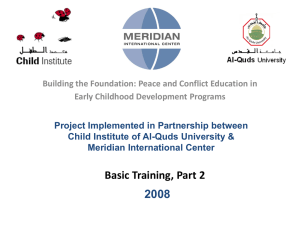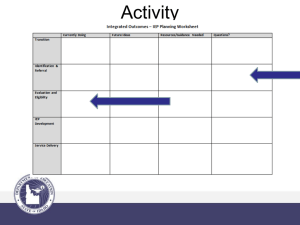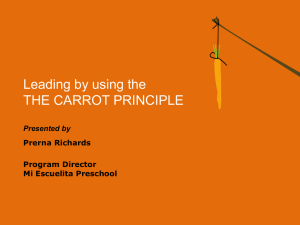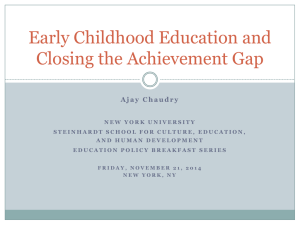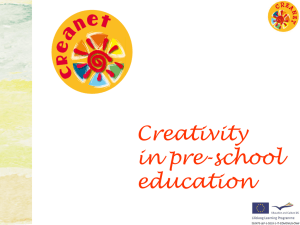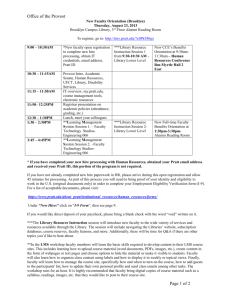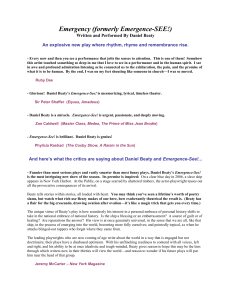Examining The Participation of Preschool Children in the Writing
advertisement
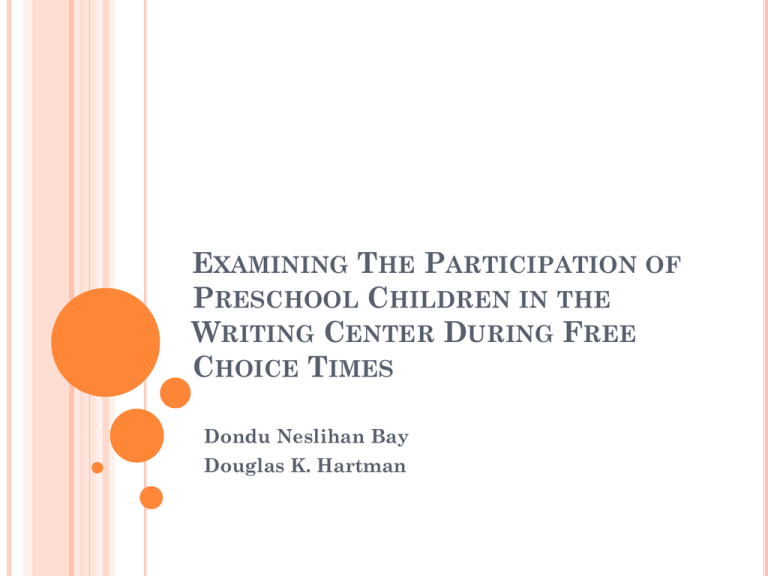
EXAMINING THE PARTICIPATION OF PRESCHOOL CHILDREN IN THE WRITING CENTER DURING FREE CHOICE TIMES Dondu Neslihan Bay Douglas K. Hartman This study is about supporting the writing skills of children. Research shows that children evolve from drawing to spelling to learning conventional writing (Vukelich & Christie, 2009). Print environments in classrooms provide important opportunities for children to observe written language. Also, the writing center is important for preschool children because this center is stocked with many materials and is organized, which encourages children’s independent and self-centered participation (Johnson, 1999; Vukelich & Christie, 2009). We know little about what children are more interested in independently, on about how much time they spend in the writing center. This study researched four and five years old children who were doing writing activities. Also, this study was designed to reveal what children prefer to do in the writing center. Thus, the focus of this study was what the effective factors are for improving children’s writing. Children want to learn how to read and write. The first level for independent writing is writing center experiences, such as copying names from a predictable chart, random letters from the alphabet, or words from a poster (Hall & Williams, 2000). Neuman, Copple, and Bredekamp (2000) noted that if teachers provide multiple opportunities for children to write freely, children are more likely to have independent interests in writing. Teachers can stock multiple types of writing instruments in their writing center (Riley, 1996), such as paper, pencils, pens, markers, paint, crayons, stamps, chalk, chalk boards, picture dictionary, scissors, stickers, etc. (Johnson, 1999; Warner & Sower, 2005; Morrow, 2007; Otto, 2008; Soderman & Farrell, 2008). In this way, children can learn how to select materials and how to put them away independently (Morrow, 2007). Teachers also can explain the center’s materials for children to use, so that children can use them actively and so that they experiment and create in the writing center such things as posters, cards, letters, and notes (Johnson, 1999; Otto, 2008). PURPOSE OF THE STUDY The aim of this study was to examine the writing center activities of preschool children during their free choice time. Specifically, this study focused on the role of the writing center in children’s writing development. Three research questions framed the study: 1. How many children use the writing center during free choice time? 2. How long do children use the writing center during their free choice time? 3. What do children do in the writing center? The professional literature suggests that teachers (a) encourage children’s emergent writing, (b) provide ample materials in writing centers, and (c) invite children to experiment and play with writing as a mode of communication (Vukelich & Christie, 2009). Little is known, however, if doing such things during free choice time is sufficient for developing motivated and proficient emergent writers. Also, much less is known about the direct effects of writing centers on children’s writing development. This study examined the preschool writing center as a site where the development of children’s emergent writing could potentially occur. By describing the frequency, duration, and uses of writing done by children at such a writing center, this study provides a snapshot for those who want to develop further opportunities for writing in the preschool classroom. METHODS & DATA This study was conducted in the child development laboratories located at a university. Participants were 18 five-year-old children in a preschool classroom. Twenty randomly selected observations of one hour each were made during free choice time. We designed a coding system for interpreting the children’s behaviors in their writing center. In the free choice times, children who came to the writing center were coded for what they did in the writing center. Coding included the number of children using the center, the duration of use, the frequency of use, and the type of activities engaged in while using the center. For the type of activities, the codes were: (1) Writing (children write letter-like forms, letters, words, etc.) (2) Drawing (children make scribbles, lines etc.) (3) Painting (children paint images up or down on the paper) (4) Copying with chart (children use stencils like letters or shapes for copying) (5) Cutting with scissors (6) Other(s) (children use other material like plaster, hole punchers, etc.) Data were collected during two months in the four- and five-year old classroom writing center. Two raters coded children’s time and their activities in the writing center. For inter-rater reliability of the coding, two raters independently coded 20 % of the observational data for the time the children spent, and for each activity in six categories. We compared the coding item by item for inter-rater agreement. Any differences were resolved by the two coders. WRITING CENTER PROPERTIES The classrooms had six centers and the writing center was in the middle of the classroom, with four chairs, one table with cupboard shelves, and one table without a cupboard, so that four children could actively use the writing center. The writing center had the same materials for children to develop their writing, such as paper, crayons, markers, glue, scissors, chalk board, erasers, envelops, stencils, colored pencils, etc. These materials were kept separately in plastic boxes on shelves. This center also had a bulletin board and a word wall, including high frequency words such as is, what, you, no. FINDINGS Table 1. Time spent by children in the writing center Time Spent (0-5) (5-10) (10-20) (20-40) (40-50) (min.) 23 10 2 Number of Times 19 (27.5%) 15 (21.8%) (33.3%) (14.5%) (2.9%) During the observations, the number of children changed from eight to 18 in their classroom, and we observed mostly one or two children at a time in the writing center. We observed that this condition related to the other centers that had interesting materials; the children spent more time in the other centers using different materials. We observed that the children who did not come to the writing center found the other centers more interesting, such as the pretend play area. The teacher just one time added encouragement materials, (relief plastic letters) to the writing center, in our seventeenth observation, so eight children came to the writing center for activities there that day. Also, the writing center sometimes had very little paper, or sometimes did not have any paper. The children usually went to get colored paper or blank paper from the art center. We observed children in the writing center 69 times, but some children came to the writing center more times than other children. Therefore, some children were coded over and over again doing the something, and some other children did not come to the writing center at all within our twenty hours of observations. The unobserved children generally preferred spending time in the other centers with their conspicuous materials. Looking at gender, the boys were observed in the writing center 12 times, and the girls were observed 57 times. The boys usually preferred the centers that attracted their attention with new added materials, such as the blocks area, the pretend play area. This finding also revealed that the girls were more interested in the writing center. An observation different from others was in the twentieth observation, when the teacher was a model for the children’s writing. She sat near the children in the writing center, and she spelled each word and wrote it on blank paper. The children then tried to read and re-write to these words. Table 2. Children’s Activities in The Writing Center Activities Writing Drawing Painting Copying (1) (2) (3) with chart (4) 12 58 42 12 Number time Percent according 14.4% 84.1% 60.9% 14.4% to the 69 coding observation Cutting with scissors (5) 16 23.2% Others (6) 21 30.4% DISCUSSION Children’s experiences related to literacy are very important for their literacy development (Fogo, 2008). For deeply understanding children’s emergent literacy behaviors, children need to be observed carefully when they participate in literacy-related events such as writing independently (Otto, 2008). Providing multiple opportunities with writing materials in the classroom encourages children’s writing skills (Neuman et al., 2000; Brewer, 2001). In this study, we observed children’s behaviors related to their writing skills at the writing center in two ways: time spent and activities. Furthermore, we described the important elements for attracting the children’s attention, such as participation according to children’s gender, how many times the teacher added new materials, how many time she participated with the children at the writing center, and what the unobserved children did in the classroom. We discuss these finding in turn. The preschool teachers can support the children with writing materials, and they can fill the writing center with material for engaging the children (Beaty & Pratt, 2007; Morrow, 2007). Clark and Kragler (2005) indicated that when preschool teachers use more writing materials, children develop more writing skills. The writing center should be interesting and inviting. Also, paper should be available for writing in the writing center (Morrow, 2007). Guo and Justice (2012) examined the association among literacy materials’ features and children’s emergent literacy in a book center and a writing center. They found positive and significant relations between the features and children developing skills such as name writing and alphabet knowledge. Research shows that when teachers add attention-grabbing materials, like stickers, cards, magazines, etc., children have many products to use with their writing skills, and they spend much time in the writing center (Rowe, 2008). Also, setting up the writing center as a newspaper office, business office, post office, etc., invites children to participate (Brewer, 2001; Beaty & Pratt, 2007; Morrow, 2007). The writing center is provided for children to practice and explore writing with tools such as paper, pencil, and chalk. Children are in a crucial time in their development of natural writing, and they need to push forward in their writing developing process. Therefore, observing children’s writing behavior is important for understanding their emergent writing (Beaty & Pratt, 2007; Neuman et al., 2000). Considering the unobserved children, the teacher should provide them with opportunities to join with the other children in the writing center (Beaty & Pratt, 2007). The teacher should model how children can use writing materials for their independent writing activities (Morrow, 2007). Rowe (2008) showed that the participation of teachers, such as talking about children’s writing in the writing center, played a powerful role, so that children strived in their writing implements, and they showed their intentions and interests with their teacher’s guidance. Teachers should be introduced to writing materials and activities in the writing center for the independent writing of children. Research has showed that children’s drawings represent their communication and understanding, and children’s drawings are important for developing their visual literacy (Anning & Ring, 2004; Hopperstad, 2010). Hopperstad (2010) found that children need to be supported to make sense of their drawings and teachers need to encourage children’s drawing related talk. Neumann, Hood, and Ford (2012) reported that when mothers applied strategies for children to develop their writing, such as pointing at and copying letters, children scaffold their emergent writing with these activities. In particular, copying of letters or shapes does not need to retrieve a template from memory, like writing and drawing do, but instead they engage each other. Copying requires motor control, and it translates as a visual pattern from the motor pattern of finger movements, so copying is crucial for children’s writing and drawing behaviors (Jerde, 2004). Also, the eye-hand coordination of children is necessary for using writing implements, because children use their hand and finger movements directly for writing. In particular, cutting practice with scissors, such as cutting cards and wrapping paper, improves their eye-hand coordination, and this activity also provides for their use of their small muscles (Beaty & Pratt, 2007). Diamond, Gerde, and Powell (2008) found the relations between children’s writing skills and their understanding of letters, and they also showed the importance of letter knowledge for children’s growth in writing. Also, Molfese and colleagues (2011) reported a strong correlation between letter writing and writing skills. Letter writing requires children to connect circles and lines, so children need to understand the meaning and purpose of their own writing in their diverse stages of writing. Preschool teachers can support alphabet knowledge by providing opportunities for children to explore (Fogo, 2008). IN CONCLUSION, This study revealed that children preferred little in the writing center; they spent little time there; they did mostly drawing activities and they did little writing activity. Our observation notes showed that it was very effective for children when new material was added to the writing center, and when the teacher participated. Future research will produce further information about participation in the writing center by children, and it will help in learning how teachers can use the writing center more effectively for supporting children’s emergent writing. Thank You FOR LISTENING

